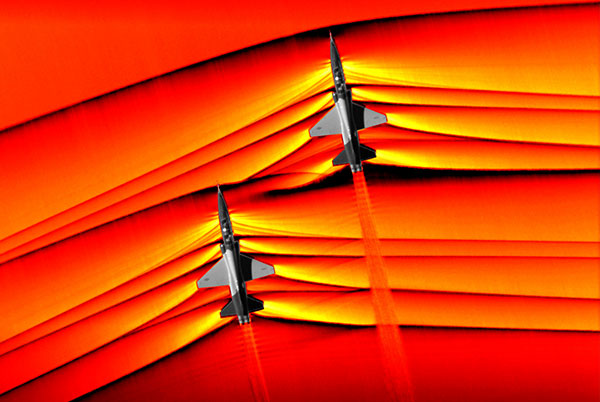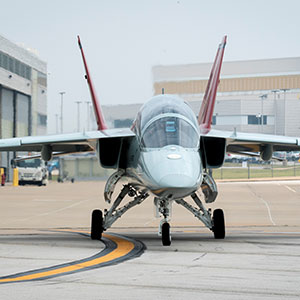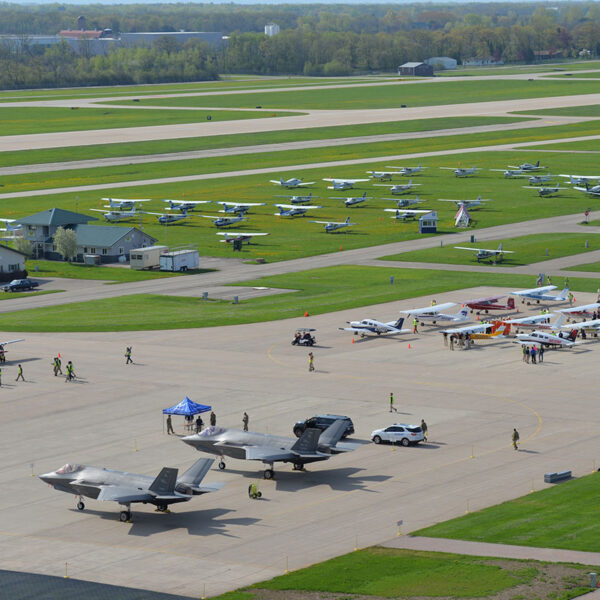2016 NIFA Distinguished Visit with the United States Navy: An Unforgettable Ride
By Contributor Josh Fisher
If you are an instrument-rated pilot or have received some instrument training, you probably recall studying spatial disorientation and the concept of somatogravic illusion. The concept is essentially that, without visual reference to your orientation, an increase in airspeed causes the sensation of pitching upward, and a decrease in airspeed causes the sensation of pitching downward. Never experienced it for real? Here’s a tip: sit in one of the aft-facing seats in the cargo hold of a windowless Grumman C-2 Greyhound on approach to one of the United States Navy’s ten aircraft carriers.
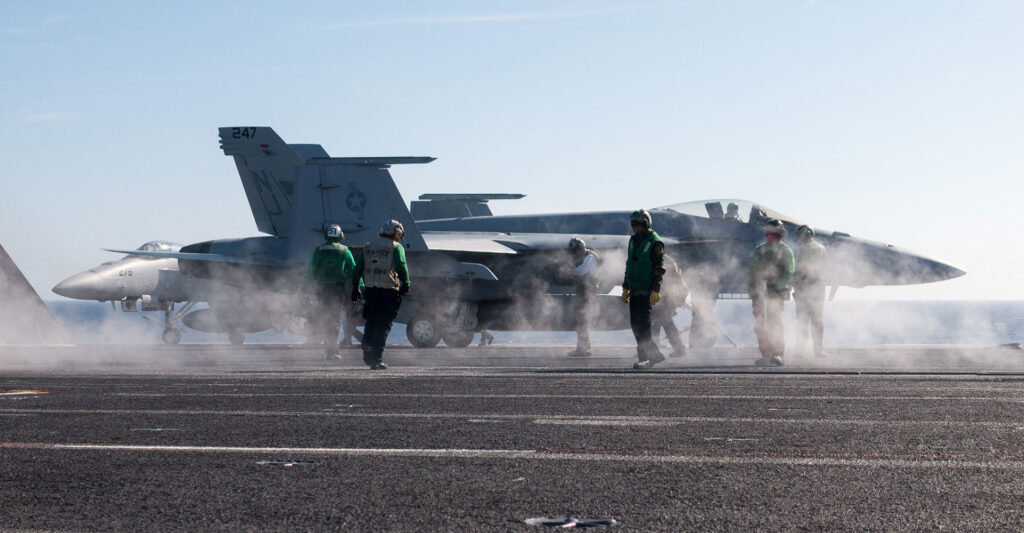
Barring you are a service person, it sounds like a pipedream, right? In 2016, I and 15 other representatives of the National Intercollegiate Flying Association (NIFA) thought so, too.
If you are an instrument-rated pilot or have received some instrument training, you probably recall studying spatial disorientation and the concept of somatogravic illusion. The concept is essentially that, without visual reference to your orientation, an increase in airspeed causes the sensation of pitching upward, and a decrease in airspeed causes the sensation of pitching downward. Never experienced it for real? Here’s a tip: sit in one of the aft-facing seats in the cargo hold of a windowless Grumman C-2 Greyhound on approach to one of the United States Navy’s ten aircraft carriers.
Barring you are a service person, it sounds like a pipedream, right? In 2016, I and 15 other representatives of the National Intercollegiate Flying Association (NIFA) thought so, too.
Several months before the start of the 2016 NIFA national competition, a plan came together for 16 representatives of NIFA to be the guests of the United States Navy on a Distinguished Visit (DV) aboard the USS Carl Vinson (CVN-70), a Nimitz Class, nuclear-powered aircraft carrier. The plan was put together mostly by Captain Darryl Stubbs (ret.), former NIFA Senior Chief Judge and Naval aviator.
A DV is a public relations visit that hosts representatives from large organizations such as educational institutions, corporations, community/industry leadership organizations, and others. The goal of a DV is to give these reps a chance to learn, via firsthand experience, the importance of the United States Navy and its personnel, equipment, and mission so that they may share this education with the communities they impact. As NIFA is an organization that seeks to enrich collegiate aviators through excellence in education, skill, and professionalism, the Navy saw our visit as an excellent opportunity to reach a very valuable population of individuals.
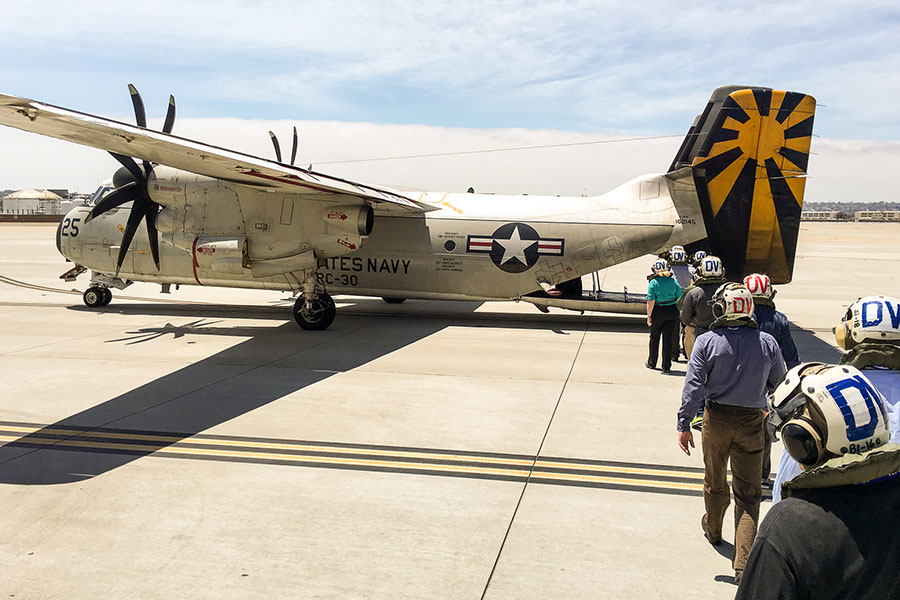
Our group assembled at Naval Air Station North Island in San Diego, CA, on June 5th, 2016. We departed North Island at approximately 2:00 PM PST aboard a US Navy Grumman C-2A Greyhound number 162145 operated by Fleet Logistics Support Squadron 30 (VRC-30), also known as the “Providers.” The C-2 is a twin-turboprop, high-wing cargo aircraft designed to carry supplies, mail, and passengers to and from aircraft carriers. This mission is known as Carrier Onboard Delivery (COD), and the Greyhound is more commonly referred to as the “Cod.”
When configured for passengers, the Cod features aft-facing seats to increase survivability in a hard landing or crash. The combination of our cranial protection, double hearing protection, and the two roaring Allison turboprops made conversation virtually impossible, however, we did exchange a quick grin and thumbs up.
The takeoff and thirty-minute flight to the ship were comparable to a typical airline flight, minus the peanuts, windows, and comfort. About thirty seconds before touchdown, the crew members in the aft cabin raised their arms and shouted, “Here we go! Here we go! Here we go!” to signal to us that the arrested landing was imminent. The props were running high, and we could hear the engines adjusting power frequently and somewhat erratically at times. This was normal.
The first sight of the deck was perhaps one of the most memorable sights of the trip.
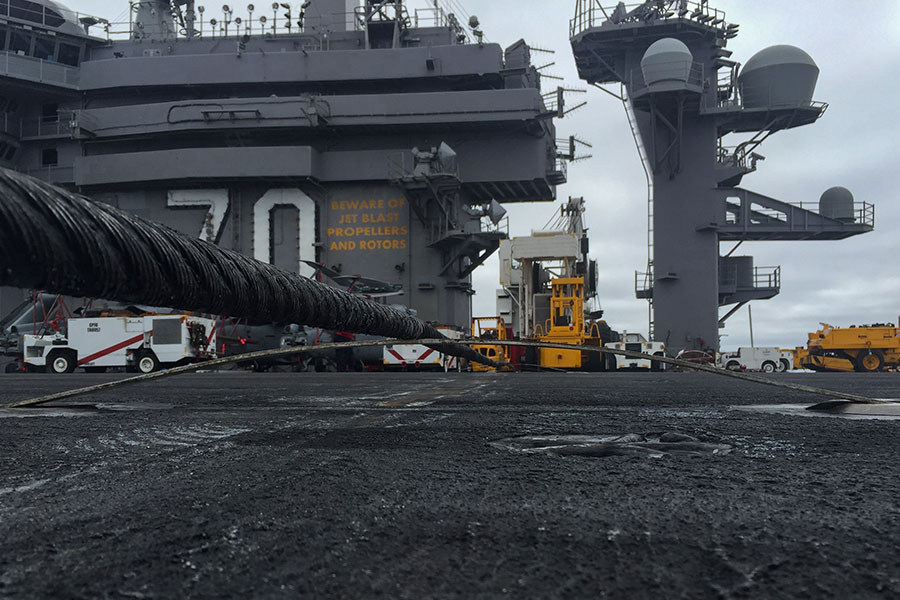
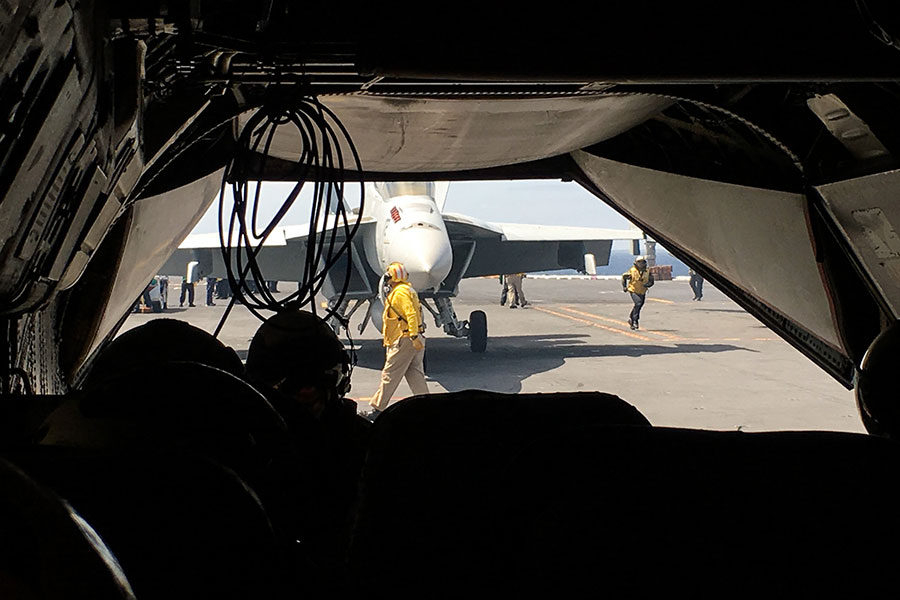
The aft cargo doors opened, and the sight of a Boeing F/A-18E Super Hornet nosing straight toward us, steam from the catapults, crew members sharply doing their various jobs, and the blue backdrop of the Pacific immediately immersed us in the Navy environment. Welcome aboard the USS Carl Vinson!
The anticipation of touchdown was almost overwhelming. All of a sudden, “SLAM!” For a split second, it was a normal landing. The engines ran up to full power in anticipation of a bolter (missed cable), and less than a second after touchdown, we felt our bodies being pressed into our seats by the massive deceleration of a carrier landing.
Good Trap! Cheers erupted from all of us!
We immediately disembarked the Cod and proceeded below deck to the Captain’s hospitality cabin. There, we learned that we arrived onboard the ship during carrier qualifications. Dozens of fresh Super Hornet pilots were getting their first attempts at landing their aircraft on the deck since they left the T-45 trainers.
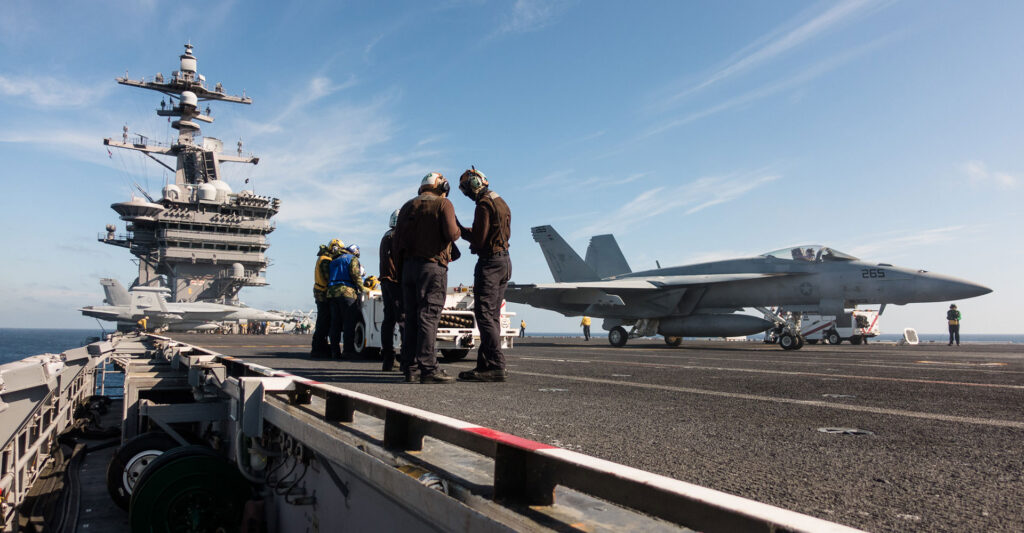
During the Captain’s welcome, I distinctly remember the ear-to-ear grin on our faces as an F/A-18 hit the deck. The Captain mentioned one very important note about our visit in his welcoming remarks. He told us that, over the next 24 hours, we would meet the ship’s crew and learn that they were “truly a cross-section of America.” He was definitely right.
Immediately after meeting the Captain, we re-donned our protective gear and proceeded to tour the flight deck. The ACTIVE flight deck. Split into two groups, we spent approximately 15 minutes in each of two stations. One station had us toward the stern of the ship, standing roughly 15 yards from the touchdown zone where the arresting cables are located. As it was carrier qualifications, a Super Hornet trapped the cables in front of us every few minutes. Occasionally, it was an EA-18 Growler. The aircraft recognition aficionados among us made sure to notice. It was truly awesome to stand so close to the action.
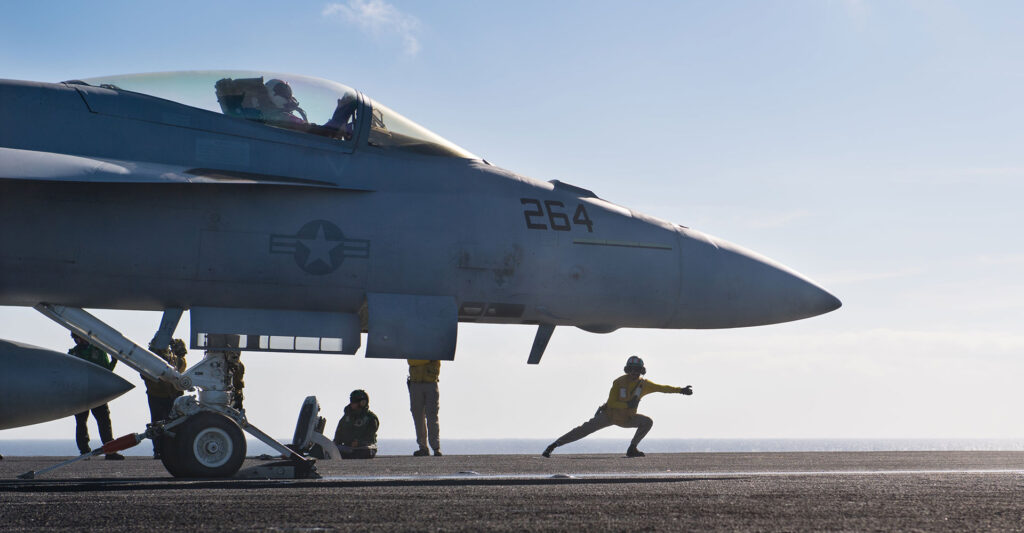
The second station was up toward the bow next to the main catapults. I have one word for you: afterburners. As you might know, Navy jets (with the exception of some more modern aircraft) set full afterburner before catapult launch from the deck. In the case of the Super Hornet, it’s full military power (maximum thrust without afterburner). You have never known the definition of the words rumble and roar until you’ve stood ten yards from two General Electric F414 engines at max power. A few pre-launch checks and then the shot – zero to 140 knots in two seconds. Later that evening, we would have the chance to observe both take-offs and landings under cover of night, which was a sight only to be described as spectacular.
We also had the opportunity to observe flight deck operations from above. From that, I can tell you this: you will never observe a harsher work environment. Jet blast everywhere, props turning, rotors spinning, aircraft moving, high winds, deafening noise; the flight deck seems like unpredictable chaos, and yet the sailors running it seem to move like the gears inside a finely constructed watch.
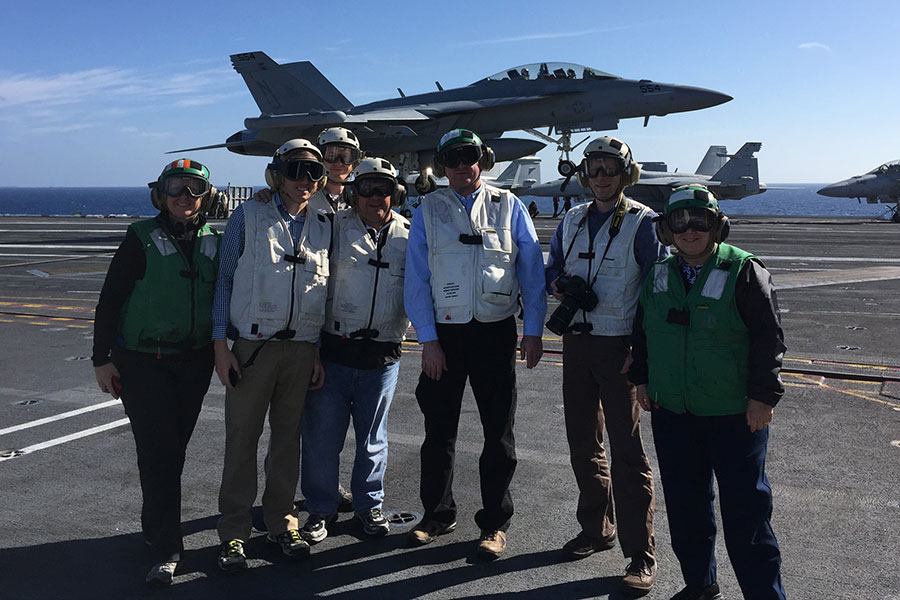
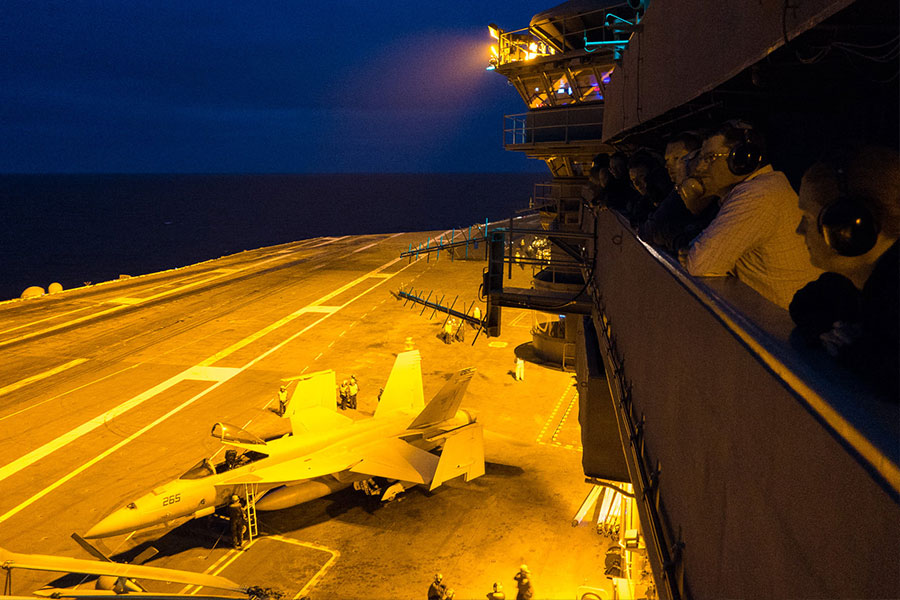
We also had the opportunity to observe flight deck operations from above. From that, I can tell you this: you will never observe a harsher work environment. Jet blast everywhere, props turning, rotors spinning, aircraft moving, high winds, deafening noise; the flight deck seems like unpredictable chaos, and yet the sailors running it seem to move like the gears inside a finely constructed watch.
I saw one sailor turn around, duck underneath an advancing wing’s leading edge, spin 270 degrees, lunge forward to dodge the horizontal stabilizer, and shield from the jet blast as the aircraft turned. It’s so finely tuned that it almost seems…safe. The job training must be intense. What’s even more intense is the trust between deck crews and flight crews. The safety of each depends on clear, accurate signaling and 100% flawless judgment and execution.
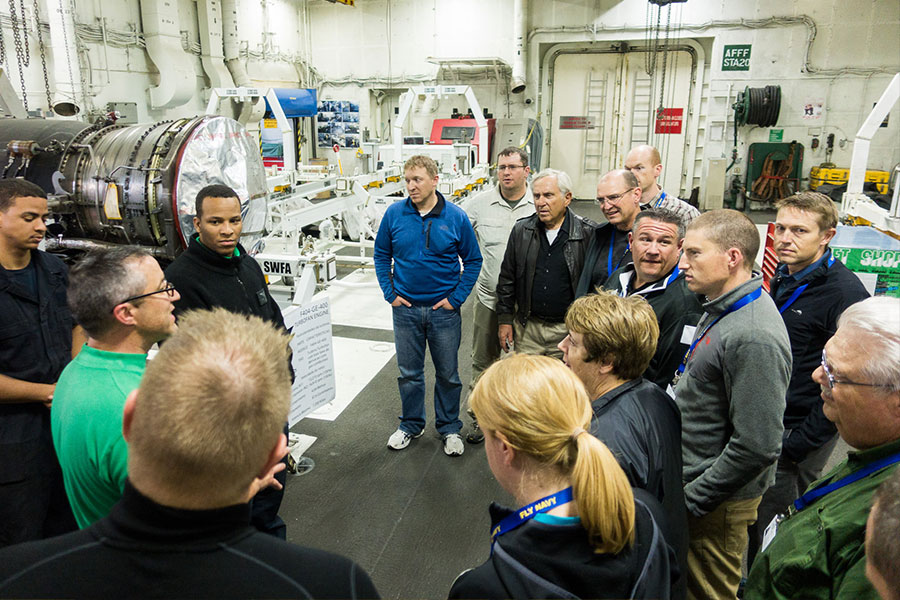
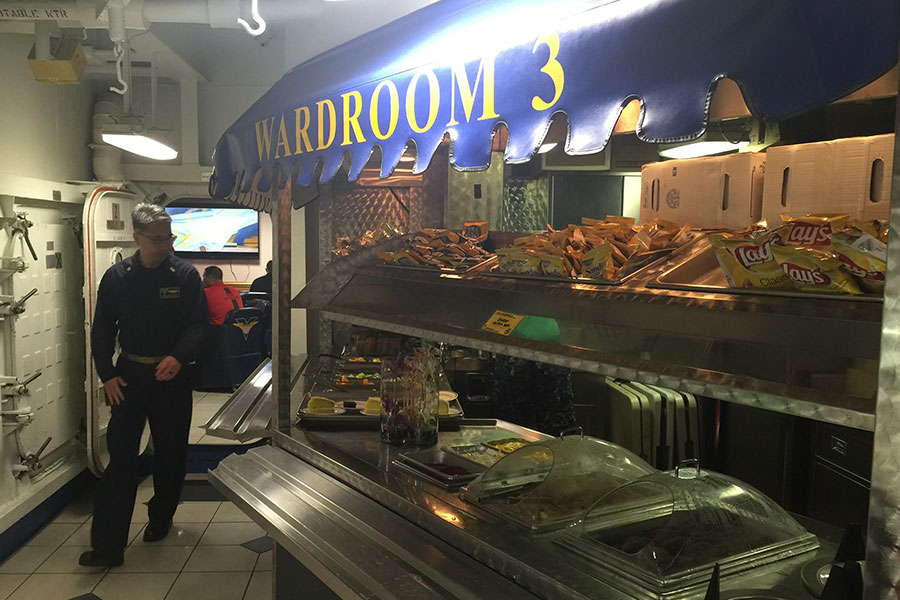
We also had the opportunity to observe flight deck operations from above. From that, I can tell you this: you will never observe a harsher work environment. Jet blast everywhere, props turning, rotors spinning, aircraft moving, high winds, deafening noise; the flight deck seems like unpredictable chaos, and yet the sailors running it seem to move like the gears inside a finely constructed watch.
Let me ask you this: how did you sleep last night? Have you ever slept one deck below an active aircraft carrier flight deck during night operations? We did. Our rooms were literally one deck below and only a matter of yards aft of the main catapults. Once every few minutes, the roar of an F/A-18 preparing for launch would fill the cabin with noise, which I can only compare to the sound of sleeping under Niagara Falls. Needless to say, getting to sleep was difficult. Also, needless to say, we really didn’t mind all that much.
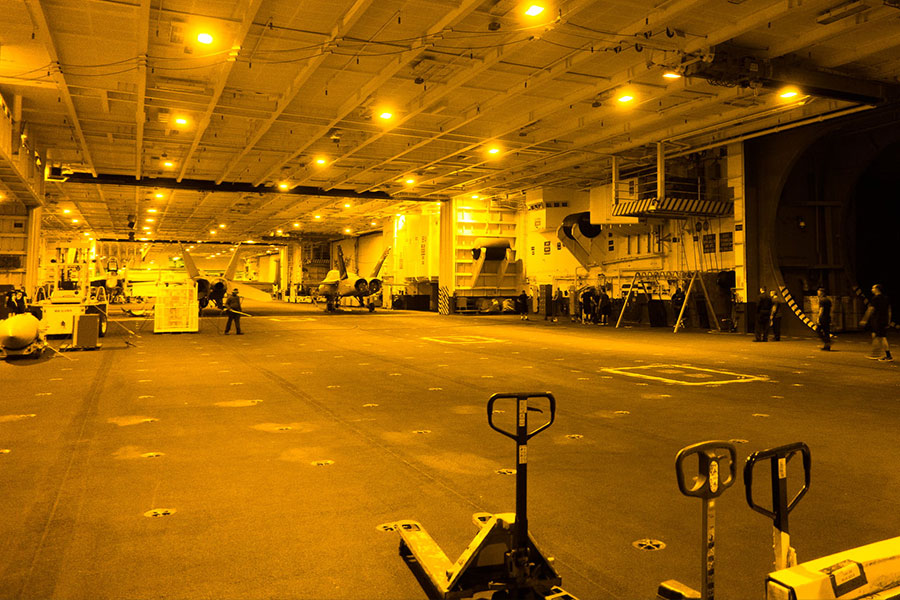
Day two was departure day. The anticipation of a catapult launch began building in all of us. As mentioned previously, in the Cod, passengers sit facing aft. Imagine yourself strapped into a seat that suddenly and instantly accelerates backwards at about 120 knots. You do not get pushed into your seat – the acceleration forces now try to throw you out of it.
As you would hope, we received a fairly detailed safety briefing prior to departure. The sailors prepped us with what I would describe as “tips and tricks to getting through a cat-shot unscathed.” We were advised that the intensity of a cat shot to the uninitiated is so great that “you’ll be begging for it to stop and, as soon as you reach that point, it will be done.”
Having put on our safety gear, we left the briefing room and proceeded, single-file, out to the flight deck and onto the Cod. Tightly strapped in, the door closed on our final view of Carl Vinson and the blue Pacific. The taxi to the catapult was fairly quick. A bump here, a knock there, and we were hooked up to the catapult. The engines ran up to max. The pre-launch checks began and the minute to follow felt like an hour.
I leaned forward into my harness as much as possible to avoid being thrown. My hands gripped the loops on my harness. Then it hit. The most extreme force I have ever felt sent us rocketing down the catapult. Muscles tensing, legs being pressed into the crossbar of the seat in front of me, the feeling was intense. Then, as if by the flip of a switch, it was over. Cheers again erupted from all of us. One or two of us may have even shouted, “Again! Again!” A little less than an hour’s flight passed, and we were back in San Diego.
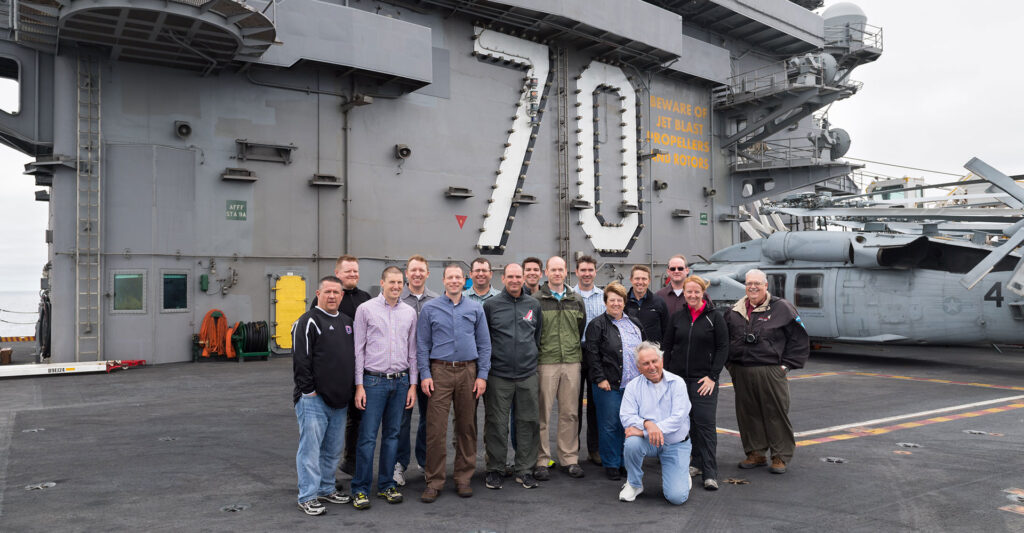
How can you sum up an experience like that? Like I said before, it was sensory overload. We got to experience something that less than a thousand civilians get to experience each year. That’s a very tiny sample of the population, a privilege and honor, as well. Here are my big takeaways:
- The men and women of the United States Military are some of the hardest-working, most dedicated people I have ever met. They make great sacrifices to do their jobs, and we should all feel comfortable and secure knowing that they are there. I believe they are the best of us.
- Becoming a Naval Aviator is an incredible feat. The training involved and the discipline required to achieve that level are likely unmatched.
- Being involved with NIFA means being a part of a vast yet distinct community. NIFA extends past the competitions. It reverberates throughout our careers as we continuously reunite with our fellow teammates and competitors in the places we least expect.
I can safely say, and I do believe I speak for my fellow representatives, that my experience as a Distinguished Visitor of the United States Navy was one of the most incredible things I have experienced in my life. It was one of those things that you never thought you would ever do and that you still cannot believe happened long after it has passed. The thing is, I have learned that this feeling is common when you are affiliated with NIFA. Being part of this community means being a leader, being a steward, and, every once in a while, being lucky. Thank you, Captain Stubbs, for orchestrating this experience for NIFA. Oh, and one last thing….GO NAVY!
Topics Related To: MODERN AVIATION
Revealing Fluid Dynamics in Flight through Schlieren Photography
Despite the stunning scenes produced of aircraft in various stages of flight, many aspects of aviation in general and aerodynamics in particular often remain invisible to the naked eye.
First Boeing T-7A Red Hawk Delivered to Air Force
The first production Boeing T-7A Red Hawk was delivered to the US Air Force on September 14, 2023. Intended to replace the aging Northrop T-38 Talon that first flew in 1959, the Red Hawk will provide a modern supersonic flight training platform for fighter and bomber pilots.
Discover National Intercollegiate Flying Association Competitions
Every year, some of the nation’s best and brightest new pilots descend upon otherwise sleepy municipal airports to participate in intense flight competitions. These aren’t competitions involving daredevil stunts or high-speed passes with afterburners, and no spectators line up to enjoy the show. These are collegiate flight competitions in which aviation students harness their skills and strive to fly as…


